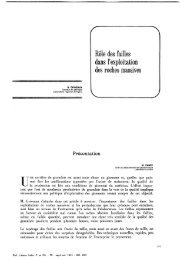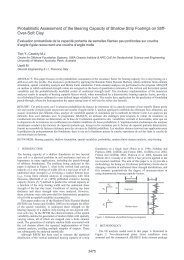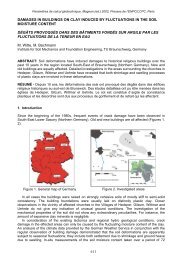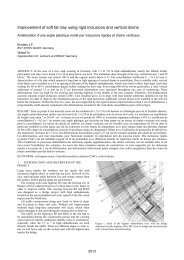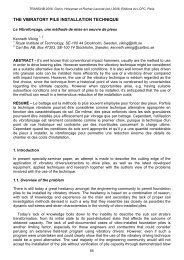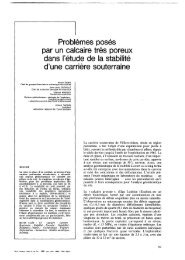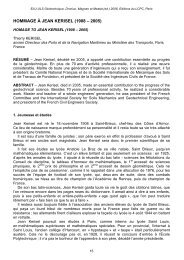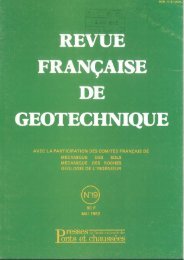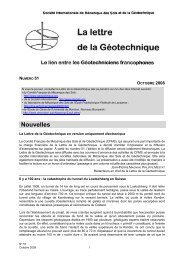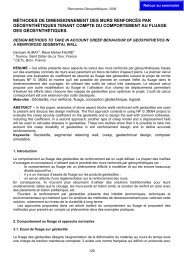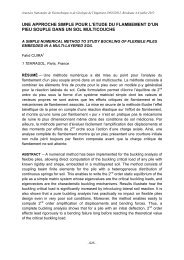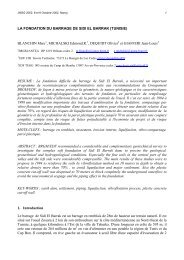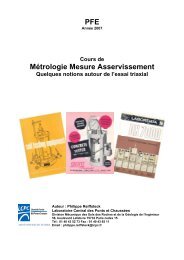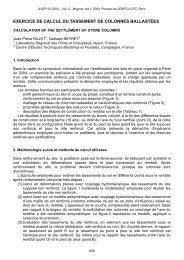La Craie
La Craie
La Craie
You also want an ePaper? Increase the reach of your titles
YUMPU automatically turns print PDFs into web optimized ePapers that Google loves.
ABSTRACTS<br />
The geology of chalk in the Paris Basin<br />
G. BIGNOT et M.P. AUBRY<br />
The authors describe the petrographic nature of chalk, which consists of detrital fragments and microfossils,<br />
ostracodes and foraminiferas, embedded in a gangue comprising a mixture of nannofossils<br />
and very small particles of calcite. The loose structure of this gangue, observed under the electron<br />
microscope, explains the mechanical behaviour of clay.<br />
The stratigraphic divisions obtained by a study of the microfauna and paleography of the Paris<br />
Basin enable geologists to define the variations of facies : chalk which tends to be detrital on the<br />
edge of the Basin, and chalk containing a high percentage of CaC03 in the centre.<br />
Knowledge of the nannofacies helps us to understand the particularities of the mechanical characteristics<br />
of the rock. Stratigraphic and petrophysical data, situating the rock in time and space,<br />
make it possible to consider geotechnical problems in a more general context.<br />
<strong>La</strong> craie, Bull. Liaison <strong>La</strong>bo. P. et Ch., special V, oct. 1973, p. 11.<br />
The petrophysics of chalk<br />
M. MASSON<br />
The petrophysical study of chalk has revealed the influence of the fine structure of the material<br />
on its physical and mechanical characteristics.<br />
We note in particular the importance of the factors brought to light in relation to the value and<br />
dispersion of mechanical strength (compressive strength, micro-hardness, speed of wave propagation)<br />
and the importance of the microscopic gangue in relation to physical characteristics (density,<br />
porosity, suction, capillary rise).<br />
The analysis of these different parameters and of their relation to geophysical problems has made<br />
it possible to define a method of identifying chalks by means of simple tests and to class them in<br />
three families : hard, semi-hard, and soft. With this method of sample study it is necessary to combine<br />
a more general method of studying chalk masses, taking account of heterogeneities due to<br />
cracking and weathering.<br />
<strong>La</strong> craie, Bull. Liaison <strong>La</strong>bo. P. et Ch., special V, oct. 1973, p. 23.<br />
The texture and behaviour of chalk<br />
A. LE ROUX<br />
Examination under the electron microscope shows the importance of the parameter of texture<br />
in the behaviour of these materials. But the intergranular bonds revealed in the whole of the materials<br />
studied vary in number from one sample to another ; there may be few of them (as in the Incarville,<br />
Sauqueville and Pacy-sur-Eure chalks) or they may be abundant, with the result that the material<br />
may pose numerous on-site problems, or it may behave satisfactorily.<br />
The study of a material which can be considered as intermediate between chalk and limestone confirms<br />
the existence of « bridges » which in this case are very clearly in evidence. Relations existing<br />
between intergranular bonds and the mechanical characteristics of the material are also confirmed.<br />
In the presence of water, the bonds are weakened (swelling of clay, for example), but they are still<br />
strong enough to prevent the material loosening. This explains, in the absence of any o ther phenomenon,<br />
the satisfactory behaviour of chalk under water ; and also explains why some chalks loosen<br />
when they are subjected to vibrations (e.g. the passage of on-site truck-mounted machinery).<br />
The preliminary study of textures should make it possible to predict behaviour and thereby provide<br />
the contractor with information about the materials he will have to work with.<br />
<strong>La</strong> craie, Bull. Liaison <strong>La</strong>bo. P. et Ch., special V, oct. 1973, p. 49.<br />
175



